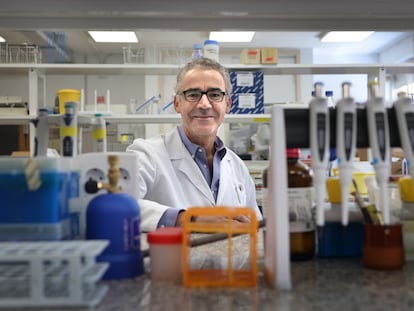Scavengers hold the secret to fighting infections
Science is investigating the habits of certain species of vultures and other animals whose defense mechanisms make them capable of digesting carrion without getting sick or dropping dead themselves

Unlike our own society, nature wastes nothing; it transforms everything. In this immense recycling machine, scavengers have a place of pride, being animals that devour organic waste and turn it back into living matter. This ability to feed on putrid food that would take humans straight to the hospital or to the grave is much more than a scientific curiosity: the field of biotechnology studies the digestive shield that protects these carrion eaters; in it, it seeks new weapons against dangerous bacteria to help us cure infections, protect crops or preserve food.
That eating carrion is a high-risk practice will come as no surprise to anyone. Decaying meat contains harmful bacteria and toxins, and the animal may have died from an infectious disease. Scavengers can also pick up germs from other scavengers who come to feast on the corpse.
And yet, the number of these species is almost uncountable, from a multitude of insects such as flies and beetles to the classic vultures and hyenas, as well as lesser-known marine scavengers such as the hagfish or slime eel, a creature without jaws or a backbone that is related to lampreys.
But if a simple meal that was a tad too spicy can have us reaching for an antacid, how do these animals manage to feed on rotting corpses without dropping dead themselves? Many different hypotheses have been proposed as a solution to this mystery, some of which are lacking any evidence, according to a study by the University of California in Los Angeles led by ecologist Daniel T. Blumstein: “We found no support that using urine to sterilize carcasses, having bald heads, eating rapidly, or food-washing behavior reduced disease risk in carrion eaters.”
Bomb-proof stomach
That conclusion does not rule out the possibility that many scavengers may take other measures to reduce the risk. Although it may seem otherwise, “some of them are very selective,” says Blumstein. In a compilation of data on the diet of more than 600 scavenger species, Tim Cushnie, an infectious disease expert at Mahasarakham University in Thailand, and his collaborators have recorded some of these behaviors: hagfish, birds such as the turkey vulture—the most widespread vulture in the Americas—and certain crabs stick only to fresh carcasses; wolves avoid eating carrion in the summer heat; crows prefer prey that’s been taken down by predators, while bearded vultures discard the meat to focus on the bones.
However, none of this completely eliminates exposure to the myriad dangers of carrion. At the National Museum of Natural History in Washington, the zoologist Gary Graves studies the digestive system of vultures to understand what makes them invulnerable to these rather indigestible foods. Graves and his colleagues discovered that the turkey vulture and the black vulture have a fairly limited microbiome in their guts, with only about 76 species of bacteria. But even though the acidity of their bomb-proof stomach acts as a filter, their intestines are dominated by lethal bacteria such as clostridia and fusobacteria, which include species that cause diseases like botulism, tetanus, gangrene and tissue necrosis.
“We have long known that these vultures exhibit substantial immunity to bacterial toxins in carrion; however, we still don’t know what genetic, molecular or cellular processes are responsible for this high tolerance,” Graves said. Blumstein added that since “there doesn’t seem to be a single way for scavengers to avoid disease, the limited number of studies tells us that we need more studies to really understand how they do it.”
New weapons against microbes
Beyond providing scientific knowledge, unravelling these unknowns may offer great practical applications. As Blumstein points out, antibiotic resistance is a huge threat to global public health. When available antibiotics are no longer effective, we will need new antimicrobial weapons, and “scavenger defenses may be a new source of antibacterial agents,” Cushnie points out. The advantage of these investigations, says the expert, is that it will be easier to uncover new findings where they have not been sought before, and the greatest promise lies in the species that ingest the most carrion in their diet and in those that consume the most rotten remains.
The work of Cushnie and his colleagues provides interesting clues that guide the work of biotechnologists: Sarcotoxin 1A, an antimicrobial protein from a fly, reduces crop pests. Serrawettin, obtained from a necrophagous beetle, is being tested as an antibacterial. Chitin, the polymer of insect exoskeletons, shields the guts of some insects; it can be extracted from the black soldier fly to prevent infections in medical implants, where bacteria often form biofilms that are difficult to remove. Some lectins, proteins that bind to sugars, can guide drugs to sites of infection. Beneficial bacteria in the guts of scavengers produce bacteriocins, compounds that are candidates for food preservatives. Other molecules from these bacteria may serve as alternatives to antibiotics in livestock farming.
According to Cushnie, it is still too early to tell which of these solutions will succeed: “Which genes, molecules or cells obtained from scavengers will be developed first for practical applications? That will depend not only on progress in the different laboratories, but also on future commercial prospects,” explains this researcher. With 90% of scavenger species still to be studied, there is reason to hope for major advances in this field.
Sign up for our weekly newsletter to get more English-language news coverage from EL PAÍS USA Edition
Tu suscripción se está usando en otro dispositivo
¿Quieres añadir otro usuario a tu suscripción?
Si continúas leyendo en este dispositivo, no se podrá leer en el otro.
FlechaTu suscripción se está usando en otro dispositivo y solo puedes acceder a EL PAÍS desde un dispositivo a la vez.
Si quieres compartir tu cuenta, cambia tu suscripción a la modalidad Premium, así podrás añadir otro usuario. Cada uno accederá con su propia cuenta de email, lo que os permitirá personalizar vuestra experiencia en EL PAÍS.
¿Tienes una suscripción de empresa? Accede aquí para contratar más cuentas.
En el caso de no saber quién está usando tu cuenta, te recomendamos cambiar tu contraseña aquí.
Si decides continuar compartiendo tu cuenta, este mensaje se mostrará en tu dispositivo y en el de la otra persona que está usando tu cuenta de forma indefinida, afectando a tu experiencia de lectura. Puedes consultar aquí los términos y condiciones de la suscripción digital.
More information
Archived In
Últimas noticias
Most viewed
- Sinaloa Cartel war is taking its toll on Los Chapitos
- Oona Chaplin: ‘I told James Cameron that I was living in a treehouse and starting a permaculture project with a friend’
- Reinhard Genzel, Nobel laureate in physics: ‘One-minute videos will never give you the truth’
- Why the price of coffee has skyrocketed: from Brazilian plantations to specialty coffee houses
- Silver prices are going crazy: This is what’s fueling the rally










































